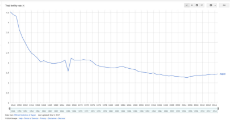https://www.japantimes.co.jp/community/2016/02/10/voices/japan-birth-rate-beginning-end-just-new-beginning/#.WgKeYmhrloP
>Catastrophe” is one of the words most frequently used to describe Japan’s demographic situation: an aging society full of sexless couples having fewer and fewer babies. Fertility is below replacement level, births are being delayed — but is the situation as desperate as the media paints it? No, the data suggest. In fact, the picture is improving.
>Japan, with its 1.43 TFR, was doing better than South Korea and Singapore (both 1.19), Hong Kong (1.12) and Germany (1.38).
>According to Myrskyla, when a country’s human development index (HDI), a composite measure of a country’s achievements in health, education and wealth, climbs over 0.86, its fertility starts to grow. If he is right, Japan, with its HDI of 0.89 (as of 2013), is going through a transition to higher TFR. Unfortunately, it is not possible to foresee how far this will go, as there are no historical precedents of long-term fertility rebound. But for now, let’s cherish this piece of much-needed good news.
Note; Myrskla's theory is not very strong. Look at the figue 1 and the link below.
https://www.researchgate.net/publication/46547111_Looking_for_a_J-shaped_development-fertility_relationship_Do_advances_in_development_really_reverse_fertility_declines
Japan is not suffering a labour shortage
[YouTube] Japan's Top Economist - Sweden Was Ruined By Immigrants (And How To Save Her)
A neutral stance on Japan's response to TFR worries.
https://www.centreforpublicimpact.org/case-study/tackling-declining-birth-rate-japan/
Automation may play a part in braving the storm too, but I lack quality information on this for now.



 Ex: Type :littlepip: to add Littlepip
Ex: Type :littlepip: to add Littlepip  Ex: Type :eqg-rarity: to add EqG Rarity
Ex: Type :eqg-rarity: to add EqG Rarity 